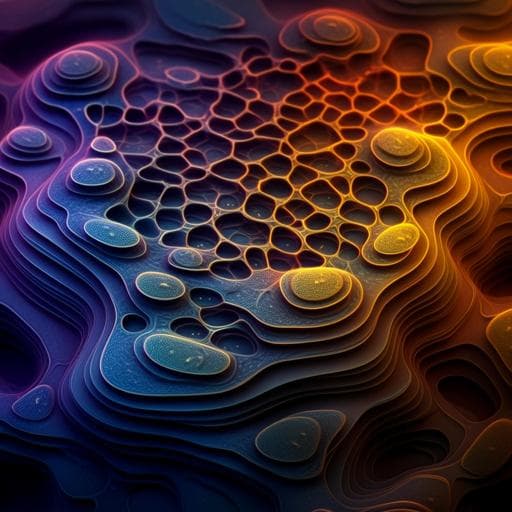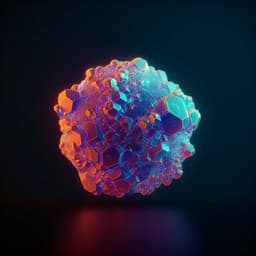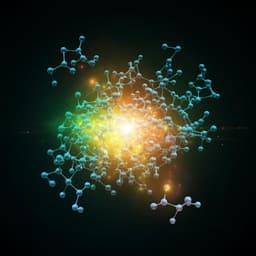
Chemistry
Vertically optimized phase separation with improved exciton diffusion enables efficient organic solar cells with thick active layers
Y. Cai, Q. Li, et al.
This groundbreaking research demonstrates the creation of thick-film organic solar cells achieving certified efficiencies of up to 16.9%, utilizing a unique combination of a polymer donor and two non-fullerene acceptors. Conducted by leading researchers including Yunhao Cai and Qian Li, this study reveals how enhanced exciton diffusion and strategic vertical phase separation can significantly boost solar cell performance.
~3 min • Beginner • English
Introduction
Organic solar cells (OSCs) offer solution processability, low cost, and mechanical flexibility. Recent advances in fused-ring non-fullerene acceptors (NFAs) have pushed single-junction efficiencies above 18%, suggesting commercialization potential. However, most high-efficiency OSCs rely on thin active layers (~100 nm), which are unsuitable for industrial roll-to-roll fabrication that benefits from thicker films (several hundred nanometers) to widen the processing window. Increasing thickness typically decreases efficiency due to limited exciton diffusion (typical L_D ~10 nm), increased trap densities, unbalanced transport, and space-charge–induced recombination. In bulk heterojunctions, excitons must reach donor/acceptor (D/A) interfaces to dissociate; thus longer exciton diffusion length and optimized vertical phase separation are crucial, especially in thick films where vertical transport distances are large. This study targets efficient thick-film OSCs by combining two NFAs with complementary absorption and enhanced exciton diffusion in their mixed phase, and by employing a layer-by-layer (LBL) approach to engineer graded vertical phase separation that facilitates charge transport and collection.
Literature Review
- High-performance OSCs (>18% PCE) have been achieved using advanced NFAs, but with optimal thicknesses ~100 nm, limiting scalable manufacturing.
- Thick-film devices face efficiency loss due to exciton diffusion limits, enhanced recombination, and transport imbalance; thick fullerene-based OSCs peaked around 11.3% at ~280 nm because of mobility imbalance.
- Bulk heterojunctions require exciton diffusion to D/A interfaces; typical L_D (~10 nm) mismatches domain sizes, exacerbated in thicker films. Strategies to improve include increasing exciton diffusion length and controlling vertical phase separation to enhance interfaces and transport.
- Prior modeling and experiments have linked thickness dependence to mobility, lifetime, and space charge, and shown that optimized morphology and vertical stratification can mitigate losses in thick films.
- Energy transfer between compatible acceptors and increased crystallinity can enhance exciton diffusion in acceptor domains, aiding thick-film performance.
Methodology
- Materials and device architecture: PM6 polymer donor with two NFAs (BTP-eC9 and L8-BO-F) as a ternary active layer; comparison with binary PM6:BTP-eC9. Device stack: ITO/PEDOT:PSS/active layer/PNDIT-F3N/Ag. Active layer thicknesses targeted: ~120, 300, 500 nm.
- Processing: Conventional blend spin-coating from chloroform with 0.5% DIO (for BTP-eC9:L8-BO-F systems) or 0.5% CN (for Y6:Y6-F systems); total D:A weight ratio 1:1.2. LBL method: spin-cast PM6 layer first, then spin-cast acceptor solution (BTP-eC9 or BTP-eC9:L8-BO-F) with same additives to form the active layer. Thermal annealing at 100 °C for 10 min. PNDIT-F3N interlayer spin-coated from methanol (0.6 mg/mL), then 100 nm Ag evaporation. Active areas: 4.0 mm² (masked 3.152 mm²) and large-area 1.0 cm² (masked 0.982 cm²).
- Photovoltaic characterization: J–V under AM 1.5G, 100 mW cm⁻²; EQE and integrated J_sc; thickness-dependent performance.
- Mobility and traps: Space-charge-limited current (SCLC) in hole-only (ITO/PEDOT:PSS/active/MoO3/Al) and electron-only (ITO/ZnO/active/PNDIT-F3N/Al) devices; analysis of ohmic, trap-filled limit (TFL), and Child regimes; trap density from V_TFL = e n_t L²/(2εε₀).
- Recombination analysis: V_oc vs light intensity slopes to assess bimolecular vs trap-assisted recombination; photocurrent (J_ph) vs effective voltage (V_eff) to estimate exciton dissociation probability (P_diss = J_ph/Jsat at short circuit).
- Exciton diffusion: Pump fluence-dependent transient absorption (TA) spectroscopy to extract exciton annihilation parameters and diffusion length L_p = (Dτ)¹ᐟ² with D = α/(8πR), assuming R = 1 nm; supported by steady-state PL and TRPL to probe Förster energy transfer and lifetimes.
- Morphology and vertical composition: Film-depth-dependent light absorption spectroscopy (FLAS) via incremental soft oxygen plasma etching with in-situ UV–vis; extraction of depth-dependent composition and optical modeling of exciton generation contours using transfer-matrix method. GIWAXS for crystalline ordering and correlation lengths; AFM for fibrillar morphology and fibril width (FWHM of line profiles).
- Energy loss analysis: Optical gap E_g from crossing of reduced PL and absorption; EL spectra and EQE_EL to determine ΔV_non-rad and total V_loss, within Marcus theory framework.
- Additional system: Validation with PM6:Y6:Y6-F following same measurements and processing, including LBL.
Key Findings
- Thick-film performance: LBL-processed PM6:BTP-eC9:L8-BO-F reached 17.31% PCE at 300 nm (certified 16.9%), with J_sc = 28.36 mA cm⁻², V_oc = 0.836 V, FF = 73.0%. At 500 nm, PCE = 15.21% (J_sc = 27.49 mA cm⁻², V_oc = 0.835 V, FF = 66.4%). At 120 nm, PCE = 18.53%.
- Conventional (non-LBL) ternary at 300 nm achieved 16.92% (J_sc = 28.27 mA cm⁻², V_oc = 0.837 V, FF = 71.5%), outperforming binary PM6:BTP-eC9 (15.62%). At 500 nm, ternary 14.45% vs binary 13.14%.
- Large-area device (1 cm²) achieved 16.01% (J_sc = 28.38 mA cm⁻², V_oc = 0.838 V, FF = 67.3%). Photostability T80 under 1-sun: 127 h (120 nm), 138 h (300 nm), 152 h (300 nm LBL).
- Exciton diffusion: L_p increased to 47.0 nm in BTP-eC9:L8-BO-F mixed acceptor film versus 36.6 nm (BTP-eC9) and 44.4 nm (L8-BO-F), attributed to efficient Förster energy transfer (quenching of L8-BO-F PL, enhanced BTP-eC9 emission) and increased crystallinity (larger π–π CCL in GIWAXS).
- Charge generation/dissociation: P_diss at short circuit—120 nm: 97.1% (binary), 98.3% (ternary), 98.2% (LBL ternary); 300 nm: 95.6%, 96.3%, 97.0% respectively.
- Transport and traps: At 300 nm LBL ternary, μ_h = 12.33 × 10⁻⁴ cm² V⁻¹ s⁻¹ and μ_e = 9.04 × 10⁻⁴ cm² V⁻¹ s⁻¹ (μ_h/μ_e = 1.36); lower trap densities in LBL ternary (1.42 × 10¹⁵ cm⁻³) vs ternary (1.50 × 10¹⁵ cm⁻³). V_oc vs light slopes (at 300 nm): 1.37 kT/q (binary), 1.32 (ternary), 1.27 (LBL ternary), indicating reduced trap-assisted recombination with L8-BO-F and further with LBL.
- Vertical morphology: FLAS-derived composition shows graded vertical phase separation in LBL ternary with acceptor-rich top (near cathode), improving electron transport/collection critical for thick films where exciton generation is biased near the PEDOT:PSS side. AFM fibril widths increased from 9.6 nm (binary) to 11.6 nm (ternary) to 16.3 nm (LBL), indicating altered aggregation. GIWAXS indicates enhanced molecular order in ternary and further in LBL films.
- Recombination dynamics: ns-TA shows longer-lived free polarons at increased thickness; 500 nm LBL maintains carrier lifetimes, whereas conventional ternary at 500 nm shows reduced lifetimes, consistent with increased trap-assisted recombination in non-LBL thick films.
- Energy loss: E_g ≈ 1.42 eV for all; total V_loss: 0.60 V (binary), 0.58 V (ternary and LBL). EQE_EL: 9.5×10⁻⁵ (binary), 1.1×10⁻⁴ (ternary), 2.0×10⁻⁴ (LBL) with ΔV_non-rad = 0.23, 0.23, and 0.21 V respectively, indicating reduced non-radiative losses with LBL.
- Generality: Applying criteria (efficient energy transfer and increased crystallinity) to Y6/Y6-F increased L_p to 37.9 nm (vs 30.7 nm in Y6). PM6:Y6:Y6-F devices improved PCE by 4.17%, 6.10%, and 6.23% (at 120, 300, 500 nm) over binary; LBL yielded 15.42% (300 nm) and 14.70% (500 nm).
Discussion
The study demonstrates that combining two compatible NFAs to form a mixed acceptor domain with enhanced exciton diffusion, together with engineered vertical stratification via LBL processing, effectively addresses the core limitations of thick-film OSCs. Enlarged exciton diffusion length (to ~47 nm) ensures more excitons reach D/A interfaces across larger domains, supporting robust charge generation in thicker layers. The LBL-induced graded vertical phase separation, particularly an acceptor-rich region adjacent to the cathode, aligns the internal morphology with the exciton generation profile and transport requirements in thick films. This configuration enhances electron transport and charge collection, reduces trap densities and trap-assisted recombination (evidenced by lower V_oc–light slopes and SCLC-derived trap densities), and maintains balanced mobilities, leading to higher FF and stabilized performance at 300–500 nm thickness. Energy loss analysis shows reduced non-radiative losses in LBL devices, further supporting improved interfacial quality. Collectively, these effects translate into record-level PCE retention at 300 and 500 nm, validating the approach for scalable, high-throughput OSC manufacturing.
Conclusion
Efficient thick-film OSCs were realized by leveraging enlarged exciton diffusion in a mixed acceptor phase (BTP-eC9:L8-BO-F) and by implementing LBL processing to produce graded vertical phase separation. The approach yielded 17.31% PCE at 300 nm (certified 16.9%) and 15.21% at 500 nm, with enhanced J_sc and FF, reduced trap-assisted recombination, improved molecular order, and lower non-radiative voltage losses. The material selection criteria—(1) efficient energy transfer between NFAs and (2) increased crystallinity upon mixing—were validated in an additional system (Y6:Y6-F), achieving 15.42% at 300 nm and 14.70% at 500 nm with LBL. These findings provide a generalizable pathway to high-performance, manufacturable thick-film OSCs. Future work could explore broader donor/acceptor combinations satisfying the criteria, optimize LBL/blade-coating for roll-to-roll processes, and enhance long-term operational stability.
Limitations
- The demonstrations focus on specific donor/acceptor systems (PM6 with BTP-eC9/L8-BO-F and Y6/Y6-F) and a single device architecture; generality to other material sets and architectures remains to be proven experimentally.
- Despite improved retention, PCE still decreases with thickness (e.g., FF reduction at 500 nm), indicating remaining transport/recombination constraints in very thick films.
- Photostability assessments showed modest T80 values (127–152 h) under continuous illumination, and long-term operational stability under varied environmental conditions was not extensively studied.
- Processing was performed by spin-coating under controlled lab conditions; translation to industrial roll-to-roll deposition may require further optimization of morphology control and solvent systems.
Related Publications
Explore these studies to deepen your understanding of the subject.







